Financial Accounting: Brooks City Firm Case Study and Analysis
VerifiedAdded on 2023/01/10
|22
|4853
|86
Homework Assignment
AI Summary
This document provides a comprehensive solution to a financial accounting assignment, focusing on the operations of Brooks City accounting firm in London. The assignment covers core concepts such as single and double-entry bookkeeping, detailing the processes of sales, purchases, receipts, and payments. It includes journal entries, ledger accounts, and a trial balance, demonstrating the recording and summarization of financial transactions. Furthermore, the assignment differentiates between financial statements and financial reports, highlighting their uses for various stakeholders like owners, management, employees, clients, and investors. Scenario-based questions explore various accounting practices. The solution provides detailed explanations and analyses to aid in understanding financial accounting principles and their practical application within a business context.

Financial Accounting
Paraphrase This Document
Need a fresh take? Get an instant paraphrase of this document with our AI Paraphraser

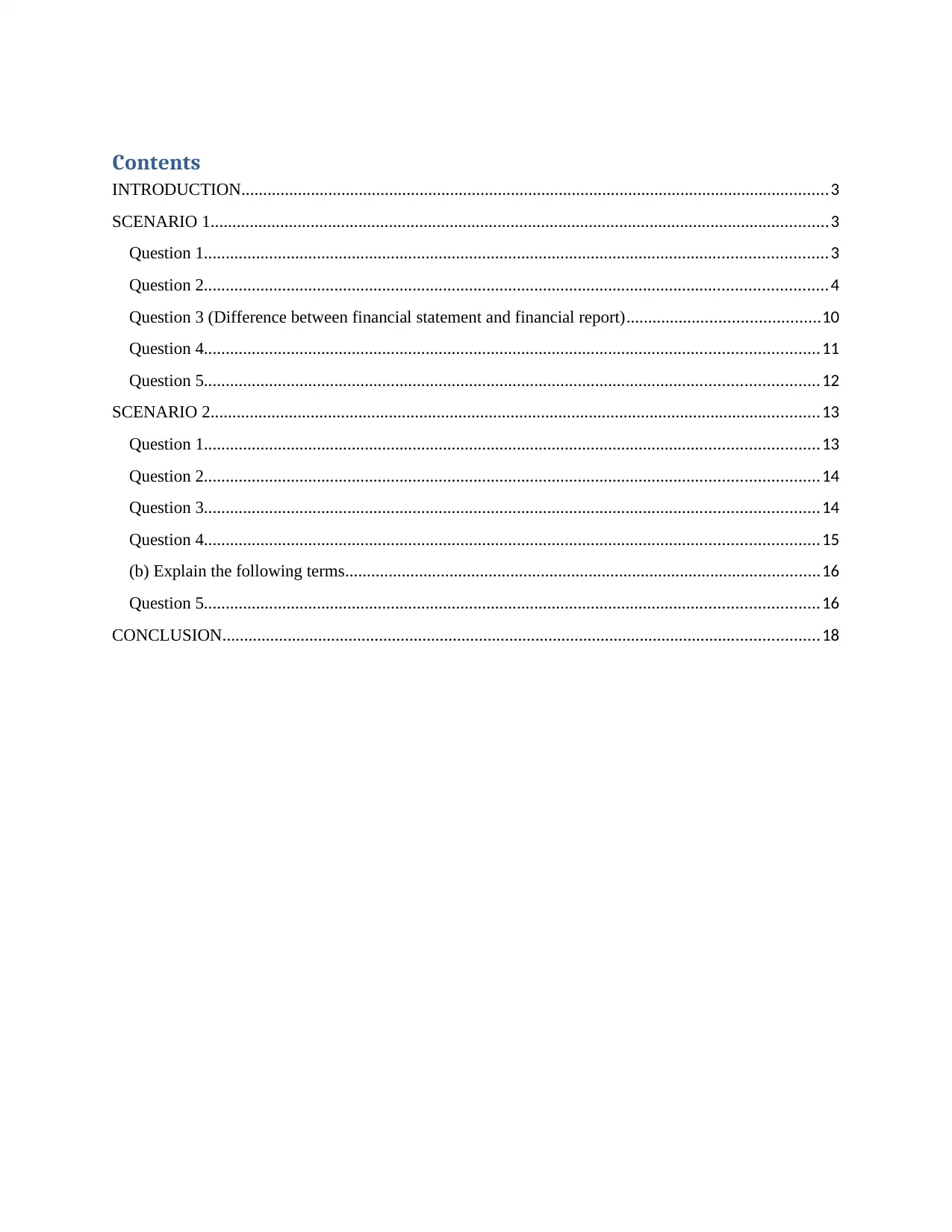
Contents
INTRODUCTION.......................................................................................................................................3
SCENARIO 1..............................................................................................................................................3
Question 1...............................................................................................................................................3
Question 2...............................................................................................................................................4
Question 3 (Difference between financial statement and financial report)............................................10
Question 4.............................................................................................................................................11
Question 5.............................................................................................................................................12
SCENARIO 2............................................................................................................................................13
Question 1.............................................................................................................................................13
Question 2.............................................................................................................................................14
Question 3.............................................................................................................................................14
Question 4.............................................................................................................................................15
(b) Explain the following terms.............................................................................................................16
Question 5.............................................................................................................................................16
CONCLUSION.........................................................................................................................................18
INTRODUCTION.......................................................................................................................................3
SCENARIO 1..............................................................................................................................................3
Question 1...............................................................................................................................................3
Question 2...............................................................................................................................................4
Question 3 (Difference between financial statement and financial report)............................................10
Question 4.............................................................................................................................................11
Question 5.............................................................................................................................................12
SCENARIO 2............................................................................................................................................13
Question 1.............................................................................................................................................13
Question 2.............................................................................................................................................14
Question 3.............................................................................................................................................14
Question 4.............................................................................................................................................15
(b) Explain the following terms.............................................................................................................16
Question 5.............................................................................................................................................16
CONCLUSION.........................................................................................................................................18
⊘ This is a preview!⊘
Do you want full access?
Subscribe today to unlock all pages.

Trusted by 1+ million students worldwide
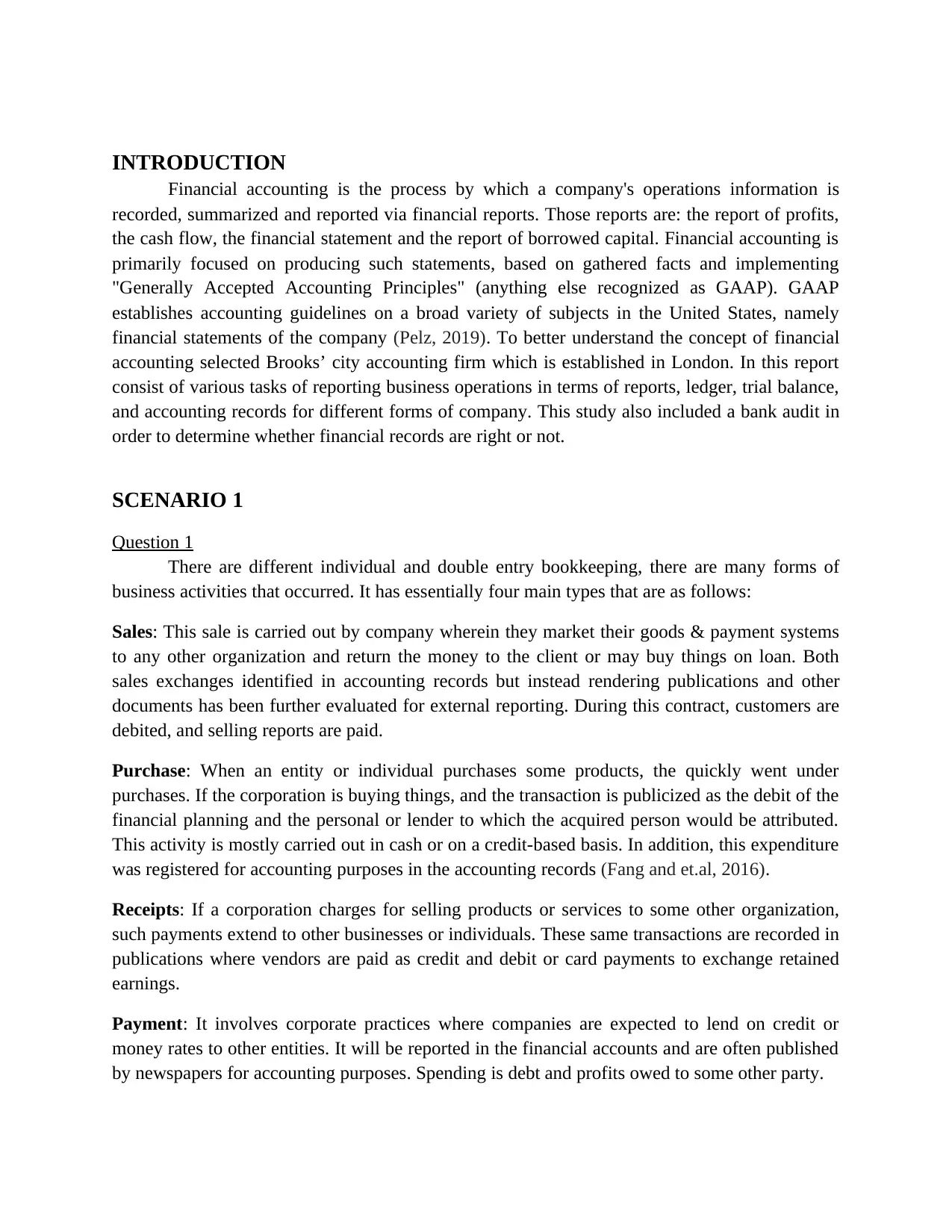
INTRODUCTION
Financial accounting is the process by which a company's operations information is
recorded, summarized and reported via financial reports. Those reports are: the report of profits,
the cash flow, the financial statement and the report of borrowed capital. Financial accounting is
primarily focused on producing such statements, based on gathered facts and implementing
"Generally Accepted Accounting Principles" (anything else recognized as GAAP). GAAP
establishes accounting guidelines on a broad variety of subjects in the United States, namely
financial statements of the company (Pelz, 2019). To better understand the concept of financial
accounting selected Brooks’ city accounting firm which is established in London. In this report
consist of various tasks of reporting business operations in terms of reports, ledger, trial balance,
and accounting records for different forms of company. This study also included a bank audit in
order to determine whether financial records are right or not.
SCENARIO 1
Question 1
There are different individual and double entry bookkeeping, there are many forms of
business activities that occurred. It has essentially four main types that are as follows:
Sales: This sale is carried out by company wherein they market their goods & payment systems
to any other organization and return the money to the client or may buy things on loan. Both
sales exchanges identified in accounting records but instead rendering publications and other
documents has been further evaluated for external reporting. During this contract, customers are
debited, and selling reports are paid.
Purchase: When an entity or individual purchases some products, the quickly went under
purchases. If the corporation is buying things, and the transaction is publicized as the debit of the
financial planning and the personal or lender to which the acquired person would be attributed.
This activity is mostly carried out in cash or on a credit-based basis. In addition, this expenditure
was registered for accounting purposes in the accounting records (Fang and et.al, 2016).
Receipts: If a corporation charges for selling products or services to some other organization,
such payments extend to other businesses or individuals. These same transactions are recorded in
publications where vendors are paid as credit and debit or card payments to exchange retained
earnings.
Payment: It involves corporate practices where companies are expected to lend on credit or
money rates to other entities. It will be reported in the financial accounts and are often published
by newspapers for accounting purposes. Spending is debt and profits owed to some other party.
Financial accounting is the process by which a company's operations information is
recorded, summarized and reported via financial reports. Those reports are: the report of profits,
the cash flow, the financial statement and the report of borrowed capital. Financial accounting is
primarily focused on producing such statements, based on gathered facts and implementing
"Generally Accepted Accounting Principles" (anything else recognized as GAAP). GAAP
establishes accounting guidelines on a broad variety of subjects in the United States, namely
financial statements of the company (Pelz, 2019). To better understand the concept of financial
accounting selected Brooks’ city accounting firm which is established in London. In this report
consist of various tasks of reporting business operations in terms of reports, ledger, trial balance,
and accounting records for different forms of company. This study also included a bank audit in
order to determine whether financial records are right or not.
SCENARIO 1
Question 1
There are different individual and double entry bookkeeping, there are many forms of
business activities that occurred. It has essentially four main types that are as follows:
Sales: This sale is carried out by company wherein they market their goods & payment systems
to any other organization and return the money to the client or may buy things on loan. Both
sales exchanges identified in accounting records but instead rendering publications and other
documents has been further evaluated for external reporting. During this contract, customers are
debited, and selling reports are paid.
Purchase: When an entity or individual purchases some products, the quickly went under
purchases. If the corporation is buying things, and the transaction is publicized as the debit of the
financial planning and the personal or lender to which the acquired person would be attributed.
This activity is mostly carried out in cash or on a credit-based basis. In addition, this expenditure
was registered for accounting purposes in the accounting records (Fang and et.al, 2016).
Receipts: If a corporation charges for selling products or services to some other organization,
such payments extend to other businesses or individuals. These same transactions are recorded in
publications where vendors are paid as credit and debit or card payments to exchange retained
earnings.
Payment: It involves corporate practices where companies are expected to lend on credit or
money rates to other entities. It will be reported in the financial accounts and are often published
by newspapers for accounting purposes. Spending is debt and profits owed to some other party.
Paraphrase This Document
Need a fresh take? Get an instant paraphrase of this document with our AI Paraphraser
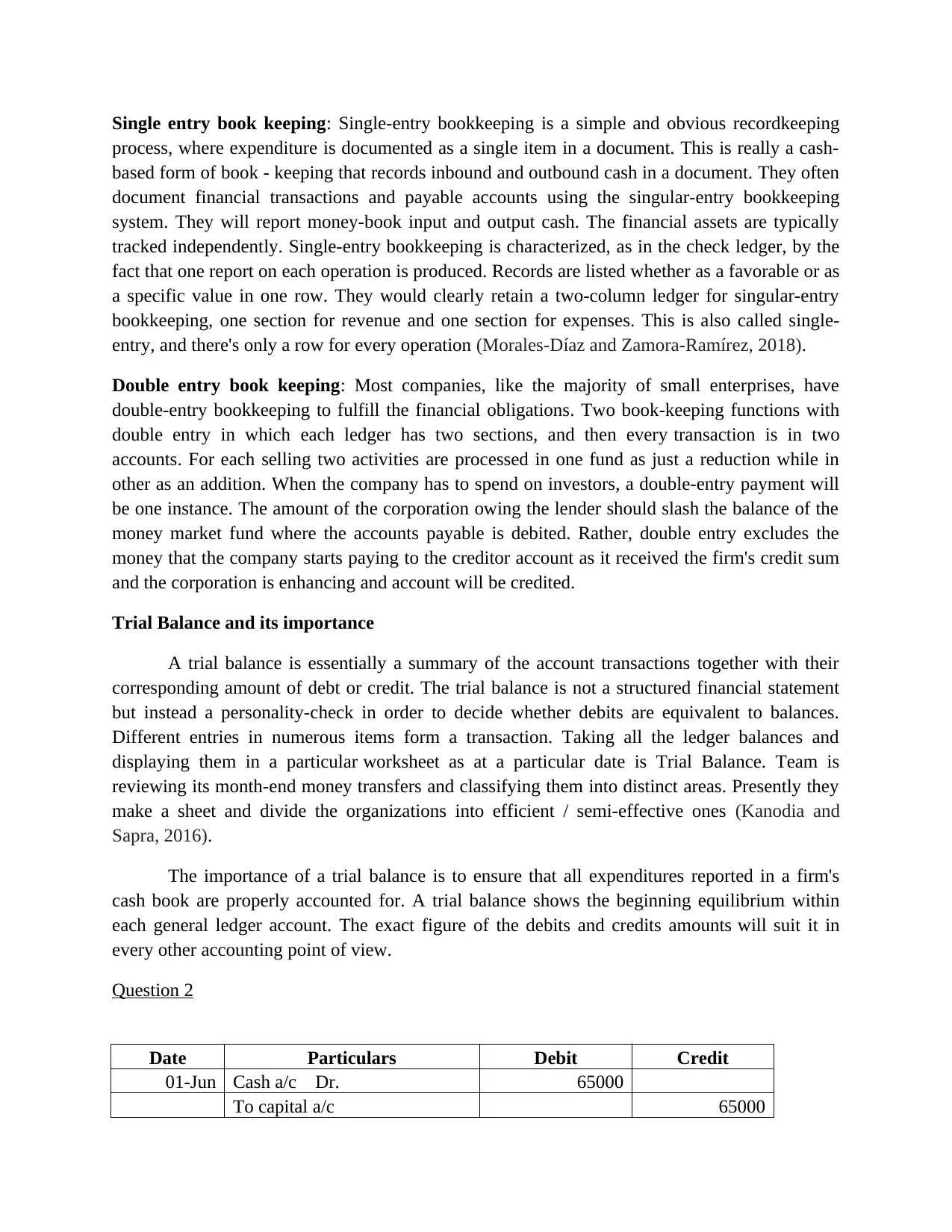
Single entry book keeping: Single-entry bookkeeping is a simple and obvious recordkeeping
process, where expenditure is documented as a single item in a document. This is really a cash-
based form of book - keeping that records inbound and outbound cash in a document. They often
document financial transactions and payable accounts using the singular-entry bookkeeping
system. They will report money-book input and output cash. The financial assets are typically
tracked independently. Single-entry bookkeeping is characterized, as in the check ledger, by the
fact that one report on each operation is produced. Records are listed whether as a favorable or as
a specific value in one row. They would clearly retain a two-column ledger for singular-entry
bookkeeping, one section for revenue and one section for expenses. This is also called single-
entry, and there's only a row for every operation (Morales-Díaz and Zamora-Ramírez, 2018).
Double entry book keeping: Most companies, like the majority of small enterprises, have
double-entry bookkeeping to fulfill the financial obligations. Two book-keeping functions with
double entry in which each ledger has two sections, and then every transaction is in two
accounts. For each selling two activities are processed in one fund as just a reduction while in
other as an addition. When the company has to spend on investors, a double-entry payment will
be one instance. The amount of the corporation owing the lender should slash the balance of the
money market fund where the accounts payable is debited. Rather, double entry excludes the
money that the company starts paying to the creditor account as it received the firm's credit sum
and the corporation is enhancing and account will be credited.
Trial Balance and its importance
A trial balance is essentially a summary of the account transactions together with their
corresponding amount of debt or credit. The trial balance is not a structured financial statement
but instead a personality-check in order to decide whether debits are equivalent to balances.
Different entries in numerous items form a transaction. Taking all the ledger balances and
displaying them in a particular worksheet as at a particular date is Trial Balance. Team is
reviewing its month-end money transfers and classifying them into distinct areas. Presently they
make a sheet and divide the organizations into efficient / semi-effective ones (Kanodia and
Sapra, 2016).
The importance of a trial balance is to ensure that all expenditures reported in a firm's
cash book are properly accounted for. A trial balance shows the beginning equilibrium within
each general ledger account. The exact figure of the debits and credits amounts will suit it in
every other accounting point of view.
Question 2
Date Particulars Debit Credit
01-Jun Cash a/c Dr. 65000
To capital a/c 65000
process, where expenditure is documented as a single item in a document. This is really a cash-
based form of book - keeping that records inbound and outbound cash in a document. They often
document financial transactions and payable accounts using the singular-entry bookkeeping
system. They will report money-book input and output cash. The financial assets are typically
tracked independently. Single-entry bookkeeping is characterized, as in the check ledger, by the
fact that one report on each operation is produced. Records are listed whether as a favorable or as
a specific value in one row. They would clearly retain a two-column ledger for singular-entry
bookkeeping, one section for revenue and one section for expenses. This is also called single-
entry, and there's only a row for every operation (Morales-Díaz and Zamora-Ramírez, 2018).
Double entry book keeping: Most companies, like the majority of small enterprises, have
double-entry bookkeeping to fulfill the financial obligations. Two book-keeping functions with
double entry in which each ledger has two sections, and then every transaction is in two
accounts. For each selling two activities are processed in one fund as just a reduction while in
other as an addition. When the company has to spend on investors, a double-entry payment will
be one instance. The amount of the corporation owing the lender should slash the balance of the
money market fund where the accounts payable is debited. Rather, double entry excludes the
money that the company starts paying to the creditor account as it received the firm's credit sum
and the corporation is enhancing and account will be credited.
Trial Balance and its importance
A trial balance is essentially a summary of the account transactions together with their
corresponding amount of debt or credit. The trial balance is not a structured financial statement
but instead a personality-check in order to decide whether debits are equivalent to balances.
Different entries in numerous items form a transaction. Taking all the ledger balances and
displaying them in a particular worksheet as at a particular date is Trial Balance. Team is
reviewing its month-end money transfers and classifying them into distinct areas. Presently they
make a sheet and divide the organizations into efficient / semi-effective ones (Kanodia and
Sapra, 2016).
The importance of a trial balance is to ensure that all expenditures reported in a firm's
cash book are properly accounted for. A trial balance shows the beginning equilibrium within
each general ledger account. The exact figure of the debits and credits amounts will suit it in
every other accounting point of view.
Question 2
Date Particulars Debit Credit
01-Jun Cash a/c Dr. 65000
To capital a/c 65000

(Being invest cash into
business)
02-Jun Purchase a/c Dr. 8000
To creditor a/c 8000
(Being purchase goods on
credit)
07-Jun Cash a/c Dr. 4000
To sales a/c 4000
(Being sell out inventory in
cash)
08-Jun Creditor a/c Dr. 4000
To Bank a/c 4000
(Being issue cheque for
purchase credit goods)
14-Jun Insurance a/c Dr. 75
To Bank a/c 75
(Being pay insurance amount
by cheque)
15-Jun Debtor a/c Dr. 12000
To Sales a/c 12000
(Being sell out inventory on
credit)
16-Jun Purchase a/c Dr. 10000
To Creditor a/c 10000
(Being purchase goods on
credit)
18-Jun Computer equipment a/c Dr. 3000
To Cash a/c 3000
(Being purchase computer
equipment)
20-Jun Rent a/c Dr. 150
To bank a/c 150
(Being paid rent by cheque)
business)
02-Jun Purchase a/c Dr. 8000
To creditor a/c 8000
(Being purchase goods on
credit)
07-Jun Cash a/c Dr. 4000
To sales a/c 4000
(Being sell out inventory in
cash)
08-Jun Creditor a/c Dr. 4000
To Bank a/c 4000
(Being issue cheque for
purchase credit goods)
14-Jun Insurance a/c Dr. 75
To Bank a/c 75
(Being pay insurance amount
by cheque)
15-Jun Debtor a/c Dr. 12000
To Sales a/c 12000
(Being sell out inventory on
credit)
16-Jun Purchase a/c Dr. 10000
To Creditor a/c 10000
(Being purchase goods on
credit)
18-Jun Computer equipment a/c Dr. 3000
To Cash a/c 3000
(Being purchase computer
equipment)
20-Jun Rent a/c Dr. 150
To bank a/c 150
(Being paid rent by cheque)
⊘ This is a preview!⊘
Do you want full access?
Subscribe today to unlock all pages.

Trusted by 1+ million students worldwide
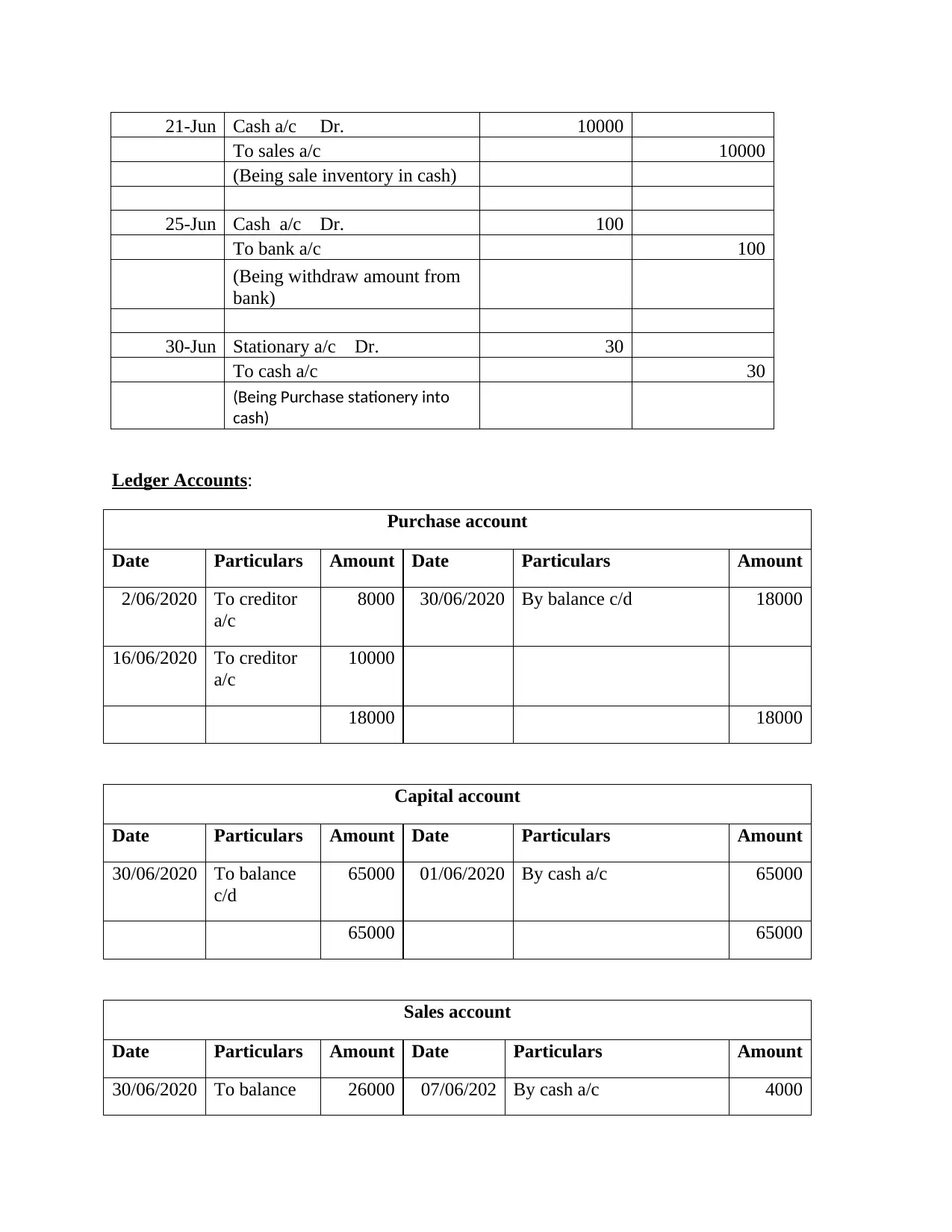
21-Jun Cash a/c Dr. 10000
To sales a/c 10000
(Being sale inventory in cash)
25-Jun Cash a/c Dr. 100
To bank a/c 100
(Being withdraw amount from
bank)
30-Jun Stationary a/c Dr. 30
To cash a/c 30
(Being Purchase stationery into
cash)
Ledger Accounts:
Purchase account
Date Particulars Amount Date Particulars Amount
2/06/2020 To creditor
a/c
8000 30/06/2020 By balance c/d 18000
16/06/2020 To creditor
a/c
10000
18000 18000
Capital account
Date Particulars Amount Date Particulars Amount
30/06/2020 To balance
c/d
65000 01/06/2020 By cash a/c 65000
65000 65000
Sales account
Date Particulars Amount Date Particulars Amount
30/06/2020 To balance 26000 07/06/202 By cash a/c 4000
To sales a/c 10000
(Being sale inventory in cash)
25-Jun Cash a/c Dr. 100
To bank a/c 100
(Being withdraw amount from
bank)
30-Jun Stationary a/c Dr. 30
To cash a/c 30
(Being Purchase stationery into
cash)
Ledger Accounts:
Purchase account
Date Particulars Amount Date Particulars Amount
2/06/2020 To creditor
a/c
8000 30/06/2020 By balance c/d 18000
16/06/2020 To creditor
a/c
10000
18000 18000
Capital account
Date Particulars Amount Date Particulars Amount
30/06/2020 To balance
c/d
65000 01/06/2020 By cash a/c 65000
65000 65000
Sales account
Date Particulars Amount Date Particulars Amount
30/06/2020 To balance 26000 07/06/202 By cash a/c 4000
Paraphrase This Document
Need a fresh take? Get an instant paraphrase of this document with our AI Paraphraser
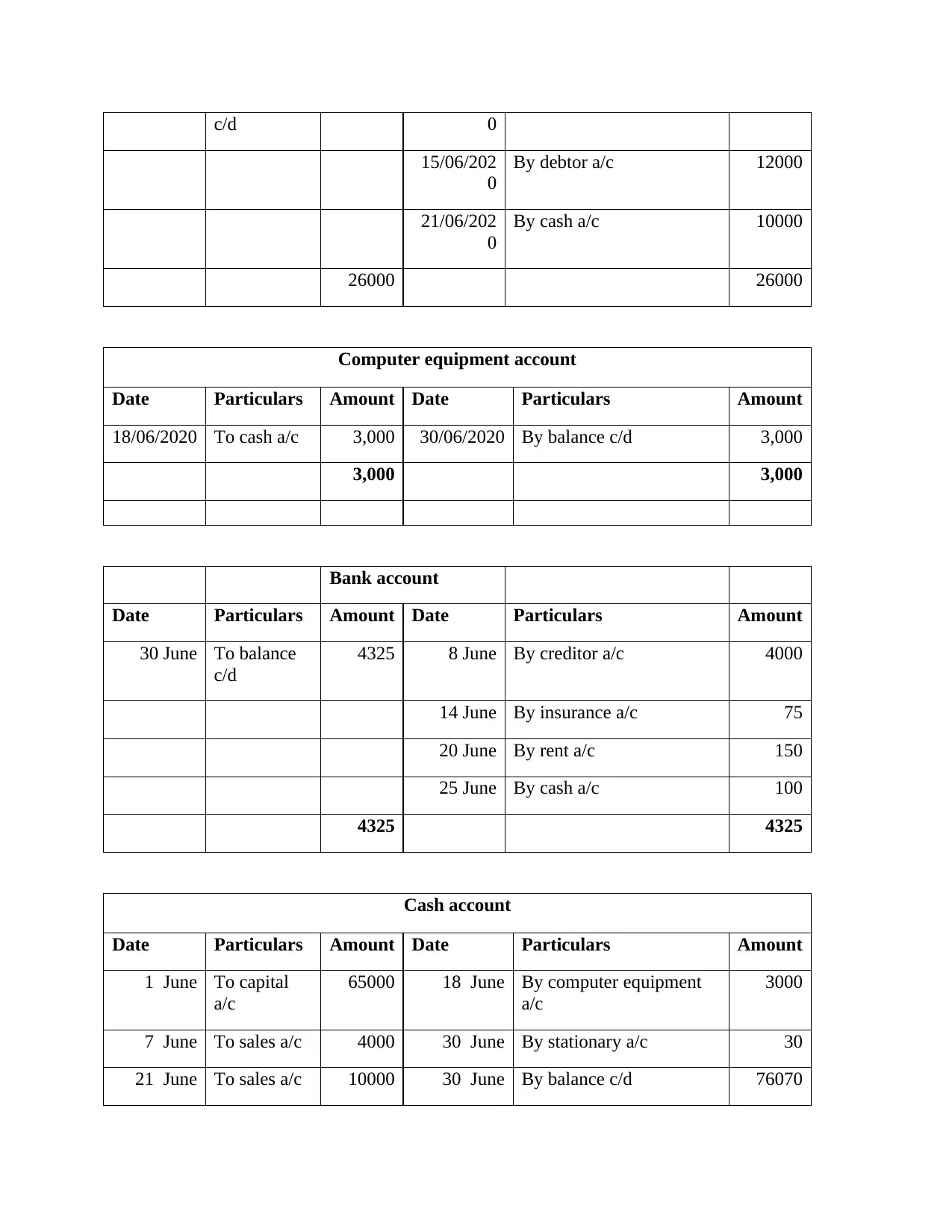
c/d 0
15/06/202
0
By debtor a/c 12000
21/06/202
0
By cash a/c 10000
26000 26000
Computer equipment account
Date Particulars Amount Date Particulars Amount
18/06/2020 To cash a/c 3,000 30/06/2020 By balance c/d 3,000
3,000 3,000
Bank account
Date Particulars Amount Date Particulars Amount
30 June To balance
c/d
4325 8 June By creditor a/c 4000
14 June By insurance a/c 75
20 June By rent a/c 150
25 June By cash a/c 100
4325 4325
Cash account
Date Particulars Amount Date Particulars Amount
1 June To capital
a/c
65000 18 June By computer equipment
a/c
3000
7 June To sales a/c 4000 30 June By stationary a/c 30
21 June To sales a/c 10000 30 June By balance c/d 76070
15/06/202
0
By debtor a/c 12000
21/06/202
0
By cash a/c 10000
26000 26000
Computer equipment account
Date Particulars Amount Date Particulars Amount
18/06/2020 To cash a/c 3,000 30/06/2020 By balance c/d 3,000
3,000 3,000
Bank account
Date Particulars Amount Date Particulars Amount
30 June To balance
c/d
4325 8 June By creditor a/c 4000
14 June By insurance a/c 75
20 June By rent a/c 150
25 June By cash a/c 100
4325 4325
Cash account
Date Particulars Amount Date Particulars Amount
1 June To capital
a/c
65000 18 June By computer equipment
a/c
3000
7 June To sales a/c 4000 30 June By stationary a/c 30
21 June To sales a/c 10000 30 June By balance c/d 76070
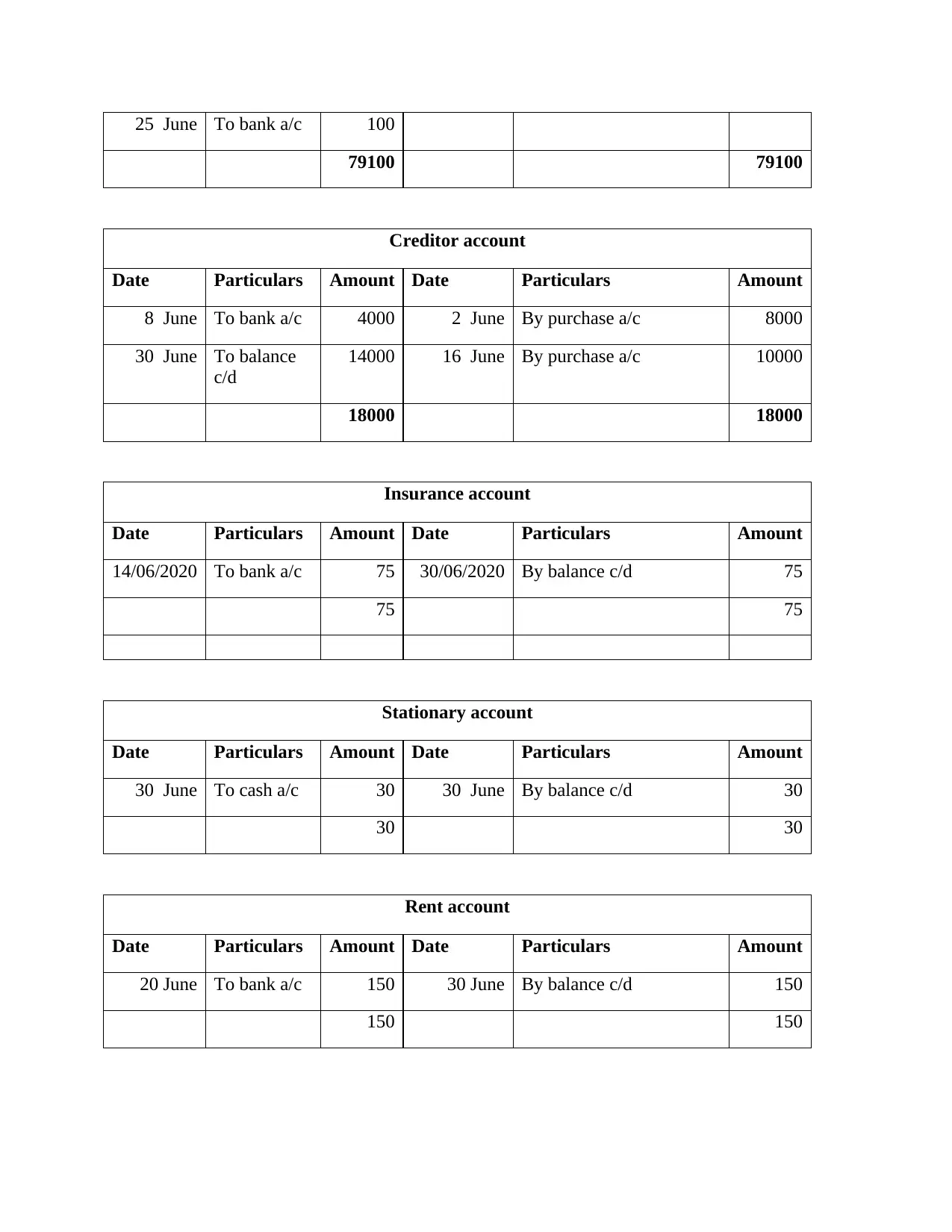
25 June To bank a/c 100
79100 79100
Creditor account
Date Particulars Amount Date Particulars Amount
8 June To bank a/c 4000 2 June By purchase a/c 8000
30 June To balance
c/d
14000 16 June By purchase a/c 10000
18000 18000
Insurance account
Date Particulars Amount Date Particulars Amount
14/06/2020 To bank a/c 75 30/06/2020 By balance c/d 75
75 75
Stationary account
Date Particulars Amount Date Particulars Amount
30 June To cash a/c 30 30 June By balance c/d 30
30 30
Rent account
Date Particulars Amount Date Particulars Amount
20 June To bank a/c 150 30 June By balance c/d 150
150 150
79100 79100
Creditor account
Date Particulars Amount Date Particulars Amount
8 June To bank a/c 4000 2 June By purchase a/c 8000
30 June To balance
c/d
14000 16 June By purchase a/c 10000
18000 18000
Insurance account
Date Particulars Amount Date Particulars Amount
14/06/2020 To bank a/c 75 30/06/2020 By balance c/d 75
75 75
Stationary account
Date Particulars Amount Date Particulars Amount
30 June To cash a/c 30 30 June By balance c/d 30
30 30
Rent account
Date Particulars Amount Date Particulars Amount
20 June To bank a/c 150 30 June By balance c/d 150
150 150
⊘ This is a preview!⊘
Do you want full access?
Subscribe today to unlock all pages.

Trusted by 1+ million students worldwide

Purchase account
Date Particulars Amount Date Particulars Amount
20 June To creditor
a/c
8000 30 June By balance c/d 18000
16 june
2020
To creditor
a/c
10000
18000 18000
Debtor account
Date Particulars Amount Date Particulars Amount
15 June To sales a/c 12000 30 June By balance c/d 12000
12000 12000
Trial balance:
Trial balance
Particulars Debit Credit
….Capital a/c 65,000
….Cash a/c 76,070
….Purchase a/c 18,000
….Creditors a/c 14,000
….Sales a/c 26,000
….Bank overdraft a/c 4,325
….Insurance a/c 75
….Rent a/c 150
….Stationary a/c 30
….Debtor a/c 12,000
Date Particulars Amount Date Particulars Amount
20 June To creditor
a/c
8000 30 June By balance c/d 18000
16 june
2020
To creditor
a/c
10000
18000 18000
Debtor account
Date Particulars Amount Date Particulars Amount
15 June To sales a/c 12000 30 June By balance c/d 12000
12000 12000
Trial balance:
Trial balance
Particulars Debit Credit
….Capital a/c 65,000
….Cash a/c 76,070
….Purchase a/c 18,000
….Creditors a/c 14,000
….Sales a/c 26,000
….Bank overdraft a/c 4,325
….Insurance a/c 75
….Rent a/c 150
….Stationary a/c 30
….Debtor a/c 12,000
Paraphrase This Document
Need a fresh take? Get an instant paraphrase of this document with our AI Paraphraser
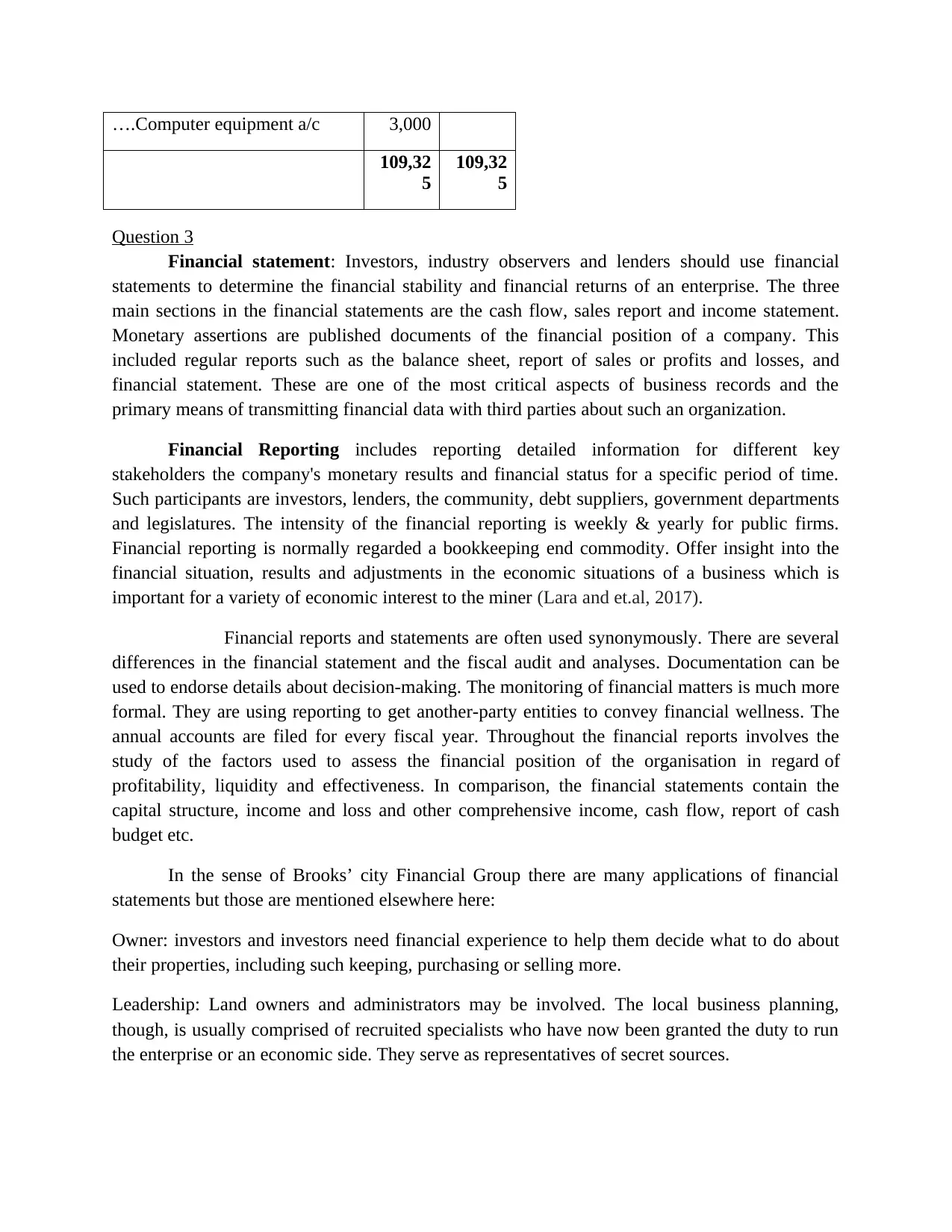
….Computer equipment a/c 3,000
109,32
5
109,32
5
Question 3
Financial statement: Investors, industry observers and lenders should use financial
statements to determine the financial stability and financial returns of an enterprise. The three
main sections in the financial statements are the cash flow, sales report and income statement.
Monetary assertions are published documents of the financial position of a company. This
included regular reports such as the balance sheet, report of sales or profits and losses, and
financial statement. These are one of the most critical aspects of business records and the
primary means of transmitting financial data with third parties about such an organization.
Financial Reporting includes reporting detailed information for different key
stakeholders the company's monetary results and financial status for a specific period of time.
Such participants are investors, lenders, the community, debt suppliers, government departments
and legislatures. The intensity of the financial reporting is weekly & yearly for public firms.
Financial reporting is normally regarded a bookkeeping end commodity. Offer insight into the
financial situation, results and adjustments in the economic situations of a business which is
important for a variety of economic interest to the miner (Lara and et.al, 2017).
Financial reports and statements are often used synonymously. There are several
differences in the financial statement and the fiscal audit and analyses. Documentation can be
used to endorse details about decision-making. The monitoring of financial matters is much more
formal. They are using reporting to get another-party entities to convey financial wellness. The
annual accounts are filed for every fiscal year. Throughout the financial reports involves the
study of the factors used to assess the financial position of the organisation in regard of
profitability, liquidity and effectiveness. In comparison, the financial statements contain the
capital structure, income and loss and other comprehensive income, cash flow, report of cash
budget etc.
In the sense of Brooks’ city Financial Group there are many applications of financial
statements but those are mentioned elsewhere here:
Owner: investors and investors need financial experience to help them decide what to do about
their properties, including such keeping, purchasing or selling more.
Leadership: Land owners and administrators may be involved. The local business planning,
though, is usually comprised of recruited specialists who have now been granted the duty to run
the enterprise or an economic side. They serve as representatives of secret sources.
109,32
5
109,32
5
Question 3
Financial statement: Investors, industry observers and lenders should use financial
statements to determine the financial stability and financial returns of an enterprise. The three
main sections in the financial statements are the cash flow, sales report and income statement.
Monetary assertions are published documents of the financial position of a company. This
included regular reports such as the balance sheet, report of sales or profits and losses, and
financial statement. These are one of the most critical aspects of business records and the
primary means of transmitting financial data with third parties about such an organization.
Financial Reporting includes reporting detailed information for different key
stakeholders the company's monetary results and financial status for a specific period of time.
Such participants are investors, lenders, the community, debt suppliers, government departments
and legislatures. The intensity of the financial reporting is weekly & yearly for public firms.
Financial reporting is normally regarded a bookkeeping end commodity. Offer insight into the
financial situation, results and adjustments in the economic situations of a business which is
important for a variety of economic interest to the miner (Lara and et.al, 2017).
Financial reports and statements are often used synonymously. There are several
differences in the financial statement and the fiscal audit and analyses. Documentation can be
used to endorse details about decision-making. The monitoring of financial matters is much more
formal. They are using reporting to get another-party entities to convey financial wellness. The
annual accounts are filed for every fiscal year. Throughout the financial reports involves the
study of the factors used to assess the financial position of the organisation in regard of
profitability, liquidity and effectiveness. In comparison, the financial statements contain the
capital structure, income and loss and other comprehensive income, cash flow, report of cash
budget etc.
In the sense of Brooks’ city Financial Group there are many applications of financial
statements but those are mentioned elsewhere here:
Owner: investors and investors need financial experience to help them decide what to do about
their properties, including such keeping, purchasing or selling more.
Leadership: Land owners and administrators may be involved. The local business planning,
though, is usually comprised of recruited specialists who have now been granted the duty to run
the enterprise or an economic side. They serve as representatives of secret sources.
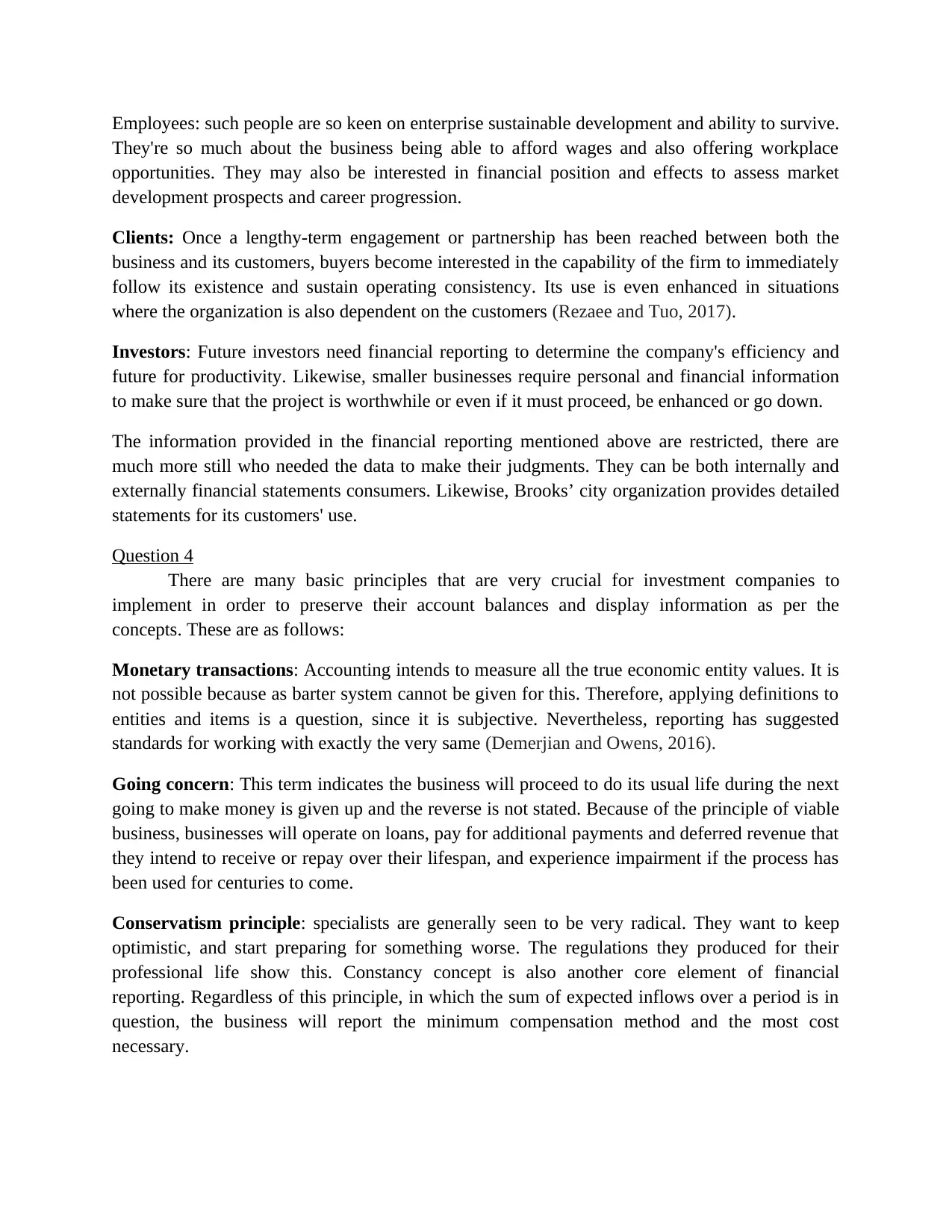
Employees: such people are so keen on enterprise sustainable development and ability to survive.
They're so much about the business being able to afford wages and also offering workplace
opportunities. They may also be interested in financial position and effects to assess market
development prospects and career progression.
Clients: Once a lengthy-term engagement or partnership has been reached between both the
business and its customers, buyers become interested in the capability of the firm to immediately
follow its existence and sustain operating consistency. Its use is even enhanced in situations
where the organization is also dependent on the customers (Rezaee and Tuo, 2017).
Investors: Future investors need financial reporting to determine the company's efficiency and
future for productivity. Likewise, smaller businesses require personal and financial information
to make sure that the project is worthwhile or even if it must proceed, be enhanced or go down.
The information provided in the financial reporting mentioned above are restricted, there are
much more still who needed the data to make their judgments. They can be both internally and
externally financial statements consumers. Likewise, Brooks’ city organization provides detailed
statements for its customers' use.
Question 4
There are many basic principles that are very crucial for investment companies to
implement in order to preserve their account balances and display information as per the
concepts. These are as follows:
Monetary transactions: Accounting intends to measure all the true economic entity values. It is
not possible because as barter system cannot be given for this. Therefore, applying definitions to
entities and items is a question, since it is subjective. Nevertheless, reporting has suggested
standards for working with exactly the very same (Demerjian and Owens, 2016).
Going concern: This term indicates the business will proceed to do its usual life during the next
going to make money is given up and the reverse is not stated. Because of the principle of viable
business, businesses will operate on loans, pay for additional payments and deferred revenue that
they intend to receive or repay over their lifespan, and experience impairment if the process has
been used for centuries to come.
Conservatism principle: specialists are generally seen to be very radical. They want to keep
optimistic, and start preparing for something worse. The regulations they produced for their
professional life show this. Constancy concept is also another core element of financial
reporting. Regardless of this principle, in which the sum of expected inflows over a period is in
question, the business will report the minimum compensation method and the most cost
necessary.
They're so much about the business being able to afford wages and also offering workplace
opportunities. They may also be interested in financial position and effects to assess market
development prospects and career progression.
Clients: Once a lengthy-term engagement or partnership has been reached between both the
business and its customers, buyers become interested in the capability of the firm to immediately
follow its existence and sustain operating consistency. Its use is even enhanced in situations
where the organization is also dependent on the customers (Rezaee and Tuo, 2017).
Investors: Future investors need financial reporting to determine the company's efficiency and
future for productivity. Likewise, smaller businesses require personal and financial information
to make sure that the project is worthwhile or even if it must proceed, be enhanced or go down.
The information provided in the financial reporting mentioned above are restricted, there are
much more still who needed the data to make their judgments. They can be both internally and
externally financial statements consumers. Likewise, Brooks’ city organization provides detailed
statements for its customers' use.
Question 4
There are many basic principles that are very crucial for investment companies to
implement in order to preserve their account balances and display information as per the
concepts. These are as follows:
Monetary transactions: Accounting intends to measure all the true economic entity values. It is
not possible because as barter system cannot be given for this. Therefore, applying definitions to
entities and items is a question, since it is subjective. Nevertheless, reporting has suggested
standards for working with exactly the very same (Demerjian and Owens, 2016).
Going concern: This term indicates the business will proceed to do its usual life during the next
going to make money is given up and the reverse is not stated. Because of the principle of viable
business, businesses will operate on loans, pay for additional payments and deferred revenue that
they intend to receive or repay over their lifespan, and experience impairment if the process has
been used for centuries to come.
Conservatism principle: specialists are generally seen to be very radical. They want to keep
optimistic, and start preparing for something worse. The regulations they produced for their
professional life show this. Constancy concept is also another core element of financial
reporting. Regardless of this principle, in which the sum of expected inflows over a period is in
question, the business will report the minimum compensation method and the most cost
necessary.
⊘ This is a preview!⊘
Do you want full access?
Subscribe today to unlock all pages.

Trusted by 1+ million students worldwide
1 out of 22
Related Documents
Your All-in-One AI-Powered Toolkit for Academic Success.
+13062052269
info@desklib.com
Available 24*7 on WhatsApp / Email
![[object Object]](/_next/static/media/star-bottom.7253800d.svg)
Unlock your academic potential
Copyright © 2020–2025 A2Z Services. All Rights Reserved. Developed and managed by ZUCOL.





